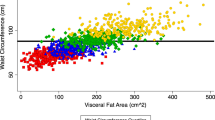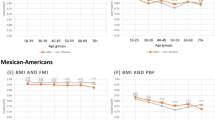Abstract
Potential differences in body composition between metabolically healthy obese (MHO) and metabolically abnormal obese (OA) adults were explored with 395 obese adults from the Pennington Center Longitudinal Study (18–68 years). Adults were classified as OA (⩾2 risk factors: blood pressure ⩾130/85 mmHg; triglycerides ⩾150 mg dl−1; high-density lipoprotein cholesterol: men <40, women <50 mg dl−1; fasting glucose ⩾100 mg dl−1; waist circumference: ⩾102 cm men, women ⩾88 cm) or MHO (<2 risk factors). Whole-body bone mineral density and content, percent body fat, fat mass, lean mass and trunk adipose tissue mass were measured with dual-energy X-ray absorptiometry. Visceral (VAT), subcutaneous (SAT) and total abdominal adipose tissue (TAT) were measured with computed tomography. Gender-specific general linear regression models were used to determine differences in body composition between MHO and OA controlling for age, race, smoking status and menopause status. In men, MHO had lower fat mass (kg and %), trunk adipose tissue, VAT, SAT, TAT and lean mass compared with OA. MHO women had lower fat mass (kg), lean mass, trunk adipose tissue, VAT and TAT when compared with OA women. In conclusion, OA and MHO cardiometabolic profiles are characterized by differences in body composition consistent between genders.
This is a preview of subscription content, access via your institution
Access options
Subscribe to this journal
Receive 12 print issues and online access
$259.00 per year
only $21.58 per issue
Buy this article
- Purchase on Springer Link
- Instant access to full article PDF
Prices may be subject to local taxes which are calculated during checkout

Similar content being viewed by others
References
Brochu M, Tchernof A, Dionne IJ, Sites CK, Eltabbakh GH, Sims EA et al. What are the physical characteristics associated with a normal metabolic profile despite a high level of obesity in postmenopausal women? J Clin Endocrinol Metab 2001; 86: 1020–1025.
Karelis AD, Brochu M, Rabasa-Lhoret R . Can we identify metabolically healthy but obese individuals (MHO)? Diabetes Metab 2004; 30: 569–572.
Primeau V, Coderre L, Karelis AD, Brochu M, Lavoie ME, Messier V et al. Characterizing the profile of obese patients who are metabolically healthy. Int J Obes (Lond) 2011; 35: 971–981.
Meigs JB, Wilson PW, Fox CS, Vasan RS, Nathan DM, Sullivan LM et al. Body mass index, metabolic syndrome, and risk of type 2 diabetes or cardiovascular disease. J Clin Endocrinol Metab 2006; 91: 2906–2912.
Durward CM, Hartman TJ, Nickols-Richardson SM . All-cause mortality risk of metabolically healthy obese individuals in NHANES III. J Obes 2012; 2012: 460321.
Jennings CL, Lambert EV, Collins M, Joffe Y, Levitt NS, Goedecke JH . Determinants of insulin-resistant phenotypes in normal-weight and obese Black African women. Obesity (Silver Spring) 2008; 16: 1602–1609.
Messier V, Karelis AD, Prud'homme D, Primeau V, Brochu M, Rabasa-Lhoret R . Identifying metabolically healthy but obese individuals in sedentary postmenopausal women. Obesity (Silver Spring) 2010; 18: 911–917.
Messier V, Karelis AD, Robillard ME, Bellefeuille P, Brochu M, Lavoie JM et al. Metabolically healthy but obese individuals: relationship with hepatic enzymes. Metabolism 2010; 59: 20–24.
Shin MJ, Hyun YJ, Kim OY, Kim JY, Jang Y, Lee JH . Weight loss effect on inflammation and LDL oxidation in metabolically healthy but obese (MHO) individuals: low inflammation and LDL oxidation in MHO women. Int J Obes (Lond) 2006; 30: 1529–1534.
You T, Ryan AS, Nicklas BJ . The metabolic syndrome in obese postmenopausal women: relationship to body composition, visceral fat, and inflammation. J Clin Endocrinol Metab 2004; 89: 5517–5522.
Stefan N, Kantartzis K, Machann J, Schick F, Thamer C, Rittig K et al. Identification and characterization of metabolically benign obesity in humans. Arch Intern Med 2008; 168: 1609–1616.
Succurro E, Marini MA, Frontoni S, Hribal ML, Andreozzi F, Lauro R et al. Insulin secretion in metabolically obese, but normal weight, and in metabolically healthy but obese individuals. Obesity (Silver Spring) 2008; 16: 1881–1886.
Ortega FN, Lee DC, Katzmarzyk PT, Ruiz JR, Sui X, Church TS et al. The intriguing metabolically healthy but obese phentoype: cardiovascular prognosis and role of fitness. Eur Heart J 2013; 34: 389–397.
Demerath EW, Sun SS, Rogers N, Lee M, Reed D, Choh AC et al. Anatomical patterning of visceral adipose tissue: race, sex, and age variation. Obesity (Silver Spring) 2007; 15: 2984–2993.
Wells JC . Sexual dimorphism of body composition. Best Pract Res Clin Endocrinol Metab 2007; 21: 415–430.
Kuk JL, Saunders TJ, Davidson LE, Ross R . Age-related changes in total and regional fat distribution. Ageing Res Rev 2009; 8: 339–348.
Katzmarzyk PT, Bray GA, Greenway FL, Johnson WD, Newton RL Jr, Ravussin E et al. Racial differences in abdominal depot-specific adiposity in white and African American adults. Am J Clin Nutr 2010; 91: 7–15.
Brochu M, Mathieu ME, Karelis AD, Doucet E, Lavoie ME, Garrel D et al. Contribution of the lean body mass to insulin resistance in postmenopausal women with visceral obesity: a Monet study. Obesity (Silver Spring) 2008; 16: 1085–1093.
Karelis AD, Faraj M, Bastard JP, St-Pierre DH, Brochu M, Prud'homme D et al. The metabolically healthy but obese individual presents a favorable inflammation profile. J Clin Endocrinol Metab 2005; 90: 4145–4150.
Marini MA, Succurro E, Frontoni S, Hribal ML, Andreozzi F, Lauro R et al. Metabolically healthy but obese women have an intermediate cardiovascular risk profile between healthy nonobese women and obese insulin-resistant women. Diabetes Care 2007; 30: 2145–2147.
Acknowledgements
This research was supported by the Pennington Biomedical Research Center. This project was partially supported by a Nutrition Obesity Research Center (NIH 2P30DK072476) Center grant from the National Institutes of Health. PTK is supported, in part, by the Louisiana Public Facilities Authority Endowed Chair in Nutrition. We specially thank Emily Mire and Connie Murla for data management, and to the many clinical scientists and staff of the Pennington Biomedical Research Center who have contributed data to the development of the Pennington Center Longitudinal Study.
Author information
Authors and Affiliations
Corresponding author
Ethics declarations
Competing interests
These authors declare no conflict of interest.
Rights and permissions
About this article
Cite this article
Camhi, S., Katzmarzyk, P. Differences in body composition between metabolically healthy obese and metabolically abnormal obese adults. Int J Obes 38, 1142–1145 (2014). https://doi.org/10.1038/ijo.2013.208
Received:
Revised:
Accepted:
Published:
Issue Date:
DOI: https://doi.org/10.1038/ijo.2013.208
Keywords
This article is cited by
-
Relevance of body composition in phenotyping the obesities
Reviews in Endocrine and Metabolic Disorders (2023)
-
Circulating levels of IL-33 are elevated by obesity and positively correlated with metabolic disorders in Chinese adults
Journal of Translational Medicine (2021)
-
Influence of the Obesity Phenotype on the Adequacy of Antibiotic Prophylaxis with Cefoxitin for Obese Patients Undergoing Bariatric Surgery: Lessons Learnt and Future Considerations
European Journal of Drug Metabolism and Pharmacokinetics (2021)
-
Fat Matters: Understanding the Role of Adipose Tissue in Health in HIV Infection
Current HIV/AIDS Reports (2016)
-
Estimation of risk for diabetes according to the metabolically healthy status stratified by degree of obesity in Korean men
Endocrine (2015)



